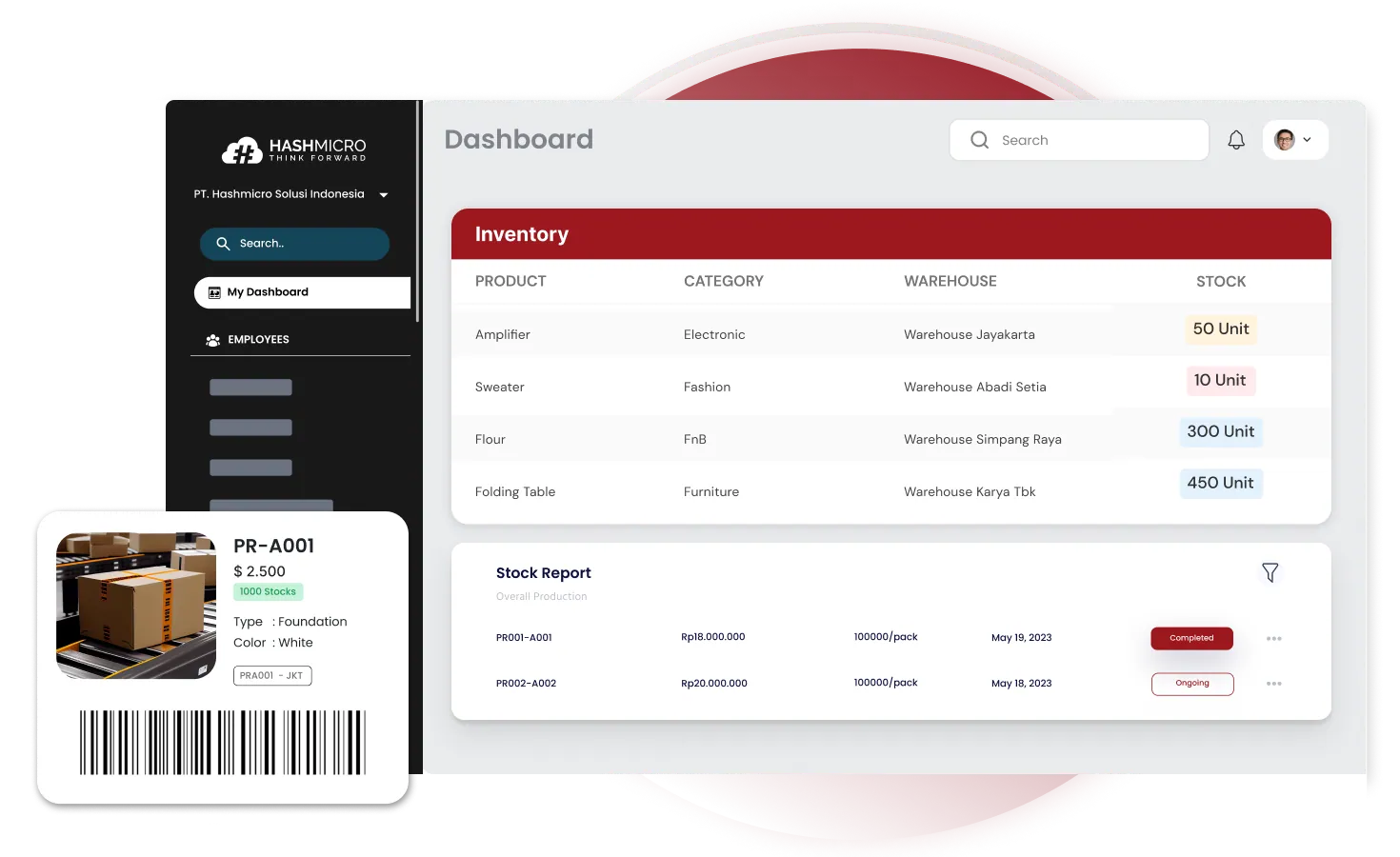Inventory control system helps businesses manage stock levels through tools and processes from purchase to warehousing and sales. Ensuring the right amount of inventory is available consistently.
Efficient inventory management is crucial for businesses in Singapore, as it allows them to meet customer demands while optimizing operational efficiency. An effective inventory control system serves as the backbone of this process, allowing businesses to maintain accurate stock levels and streamline their operations.
In this article, we will explore the essential aspects of an inventory control system, its importance, types, techniques for management, and the key differences between inventory control and inventory management.
Key Takeaways
|
Table of Content:
Table of Content

Understanding Inventory Control Systems

An inventory control system is the framework used by businesses to manage and maintain their stock levels. It involves various processes and tools that help monitor inventory from the point of purchase to warehousing and sales, ensuring that the right amount of stock is available at all times.
An inventory control system also includes the use of technologies like barcoding and RFID, which automate data collection and reduce manual errors.
A well-implemented inventory control system reduces the risk of stockouts, improves order fulfillment, and enhances overall customer satisfaction. By providing real-time insights, businesses can make data-driven decisions, improving the alignment between supply and demand.
Moreover, having a solid inventory control strategy helps businesses respond quickly to unexpected changes in customer demand and market trends. This is where inventory management software becomes invaluable by automating tasks, integrating with other business systems, and providing detailed reporting to enhance decision-making.
The Importance of Inventory Control for Business Efficiency
In today’s competitive market, having an efficient inventory control system is vital for maintaining business efficiency. Inventory control is not just about tracking stock but also about optimizing inventory levels to reduce costs and improve profitability.
Proper inventory control helps businesses balance their stock, ensuring they have enough to meet customer demand while avoiding excess that ties up capital and storage space.
Using inventory management software enhances this process by automating key tasks like updating stock levels, generating reports, and setting reorder points. These systems provide real-time data that helps businesses maintain the optimal balance between supply and demand.
Additionally, software solutions offer forecasting tools that use historical data to predict future needs, enabling businesses to stay ahead of trends and avoid disruptions caused by sudden spikes or drops in demand. Key benefits of implementing an inventory control system include:
- Improved Accuracy: Reducing human error through automation and better tracking methods.
- Optimized Stock Levels: Preventing both overstock and stockouts, especially during peak demand periods.
- Better Forecasting: Leveraging data to anticipate future needs based on historical trends, customer demand, and raw material availability.
- Increased Operational Efficiency: Streamlining processes across the supply chain, from procurement to delivery.
With these benefits, businesses can operate more smoothly, enhance cash flow, and respond quickly to market fluctuations.
Types of Inventory Control Systems

Periodic Inventory Control System
A periodic inventory system involves counting inventory at specific intervals, such as monthly, quarterly, or annually. While this approach is simple and cost-effective, it may lead to inaccurate data, especially if discrepancies go unnoticed between counts.
This system is typically more suitable for smaller businesses with straightforward inventory needs or those that do not require real-time tracking.
Perpetual Inventory Control System
A perpetual inventory system offers real-time tracking of inventory, recording every transaction as it happens. Whether it’s the sale of finished goods or the use of raw materials, each movement is updated immediately in the system. This level of precision makes it ideal for larger businesses or those with complex supply chains.
By maintaining real-time accuracy, a perpetual inventory system significantly reduces the risks of stockouts and overstocking, making it indispensable for businesses with high inventory turnover. With logistics management software, perpetual systems are fully automated, reducing manual input and enabling instant access to data across multiple departments.
Inventory Control vs. Inventory Management: Key Differences
Although the terms inventory control and inventory management are often used interchangeably, they serve different purposes within a business. Below is a table summarising the key differences between the two:
| Aspect | Inventory Control | Inventory Management |
| Focus | Tracking and maintaining stock levels | Planning and managing overall inventory strategy |
| Scope | Narrow – concerned with day-to-day operations | Broader – encompasses sourcing, storing, and selling |
| Technology Involvement | Often automated with barcoding and RFID | Involves analytics, forecasting, and supplier management |
| Main Objective | Ensuring accurate and timely stock levels | Maximizing profitability and meeting customer demand |
Understanding these differences is crucial for businesses aiming to optimize their inventory processes and achieve long-term success. For companies looking to enhance efficiency and accuracy in their inventory management, integrating a reliable software solution is key.
Inventory management software provides real-time tracking, automated inventory reporting, and seamless integration with your existing systems, helping you meet customer demand and avoid costly mistakes.
The right software solution can also offer flexible pricing plans, ensuring that businesses of all sizes can benefit from advanced features without breaking the budget. Click the banner below to explore pricing options and find the perfect inventory management system tailored to your business needs.
Effective Techniques for Managing Inventory Control

To maintain an efficient inventory control system, businesses should adopt best practices and techniques that align with their operational goals. Here are some proven techniques to consider:
Implementing Cycle Counting for Consistent Stock Accuracy
Cycle counting is a method where small portions of inventory are counted regularly instead of conducting a full inventory count once a year. This technique improves accuracy and ensures that discrepancies are caught early before they lead to larger problems.
For businesses with a large number of SKUs, cycle counting offers a practical solution to maintain stock accuracy without disrupting daily operations.
Utilizing ABC Analysis to Prioritise Inventory Management
ABC analysis categorizes inventory into three groups:
- A items: High-value items with low sales frequency.
- B items: Moderate-value items with moderate sales frequency.
- C items: Low-value items with high sales frequency.
This method helps businesses allocate resources effectively, ensuring that critical items (A items) are monitored closely, while less critical items (B and C) receive less frequent attention. ABC analysis is particularly useful when dealing with raw materials that require different management strategies based on their usage.
Integrating Barcode and RFID Technology for Streamlined Operations
Barcoding and RFID technology play a critical role in a modern inventory control system. By automating the data capture process, these technologies significantly reduce manual errors and improve tracking accuracy. Barcode scanners and RFID systems also enhance efficiency in warehouse operations, enabling faster picking, packing, and shipping.
The use of RFID tags, in particular, allows businesses to track inventory movement in real-time, providing better visibility into stock levels and ensuring timely replenishment. With inventory management software, these technologies are fully integrated, offering a unified platform for all inventory-related activities.
Best Practices for Setting Reorder Points and Safety Stock Levels
Setting appropriate reorder points and safety stock levels is key to avoiding both overstock and stockouts. Businesses need to consider factors such as lead times, customer demand, and supply chain reliability when determining these levels.
By analyzing historical data and forecasting future trends, companies can set more accurate reorder points, ensuring that they always have sufficient stock on hand without tying up too much capital in excess inventory.
Optimising Warehouse Layout for Efficient Inventory Flow
An organized warehouse layout is essential for maintaining efficient inventory flow. Grouping similar items and positioning high-turnover products in easily accessible locations can reduce picking times and improve overall productivity.
Additionally, a well-planned layout minimizes the risk of misplaced items, ensuring that products are readily available when needed. Regular reviews and adjustments to the warehouse layout, based on changes in customer demand and product lines, further enhance operational efficiency.
Simplify Your Inventory Control with HashMicro’s Inventory Management System

HashMicro’s Inventory Management System offers essential features that will streamline your inventory control, enhance efficiency, and help you stay competitive. Here’s how our system can help you manage your inventory effortlessly:
- Barcode management: Efficiently manage and track your inventory across multiple locations with speed and accuracy.
- Lot and serial number tracking: Automatically generate lot and serial numbers for hassle-free product tracking in all your warehouses.
- Stock request management: Streamline stock requests from all outlets or warehouses and automate the approval process.
- Inventory forecasting: Predict the inventory you’ll need for a specific period in the future to stay ahead.
- Inventory valuation: Quickly perform inventory valuation across all warehouses at the end of each reporting period.
- Stock aging analysis: Track the age of your stock, assess performance, and plan future stock levels for slow and fast-moving items.
Ready to take control of your inventory? Try HashMicro’s Inventory Management System today with a free demo and see how it can boost your operations.
Conclusion
Implementing a robust inventory control system is essential for businesses in Singapore to optimize operations and stay competitive. By understanding available systems, such as periodic and perpetual inventory, and adopting best practices, companies can enhance efficiency, reduce costs, and improve customer satisfaction.
Integrating inventory management software, especially cloud-based inventory solutions, ensures real-time tracking and positions businesses for long-term success. A reliable inventory system can make all the difference in today’s fast-paced market.
To truly optimize your operations, consider leveraging HashMicro’s inventory management software. Designed to streamline every aspect of inventory control, from real-time tracking to automated reporting, HashMicro’s solution ensures your business remains efficient and competitive.
With features tailored to meet the needs of businesses in Singapore, you can easily manage inventory complexities while reducing costs. Try a free demo today and Click the banner below to get started!
Frequently Asked Questions
-
What are the four common types of inventory control systems?
Inventory control systems utilize various strategies to manage stock flow within a warehouse. The four widely-used inventory control methods include ABC analysis, Last In, First Out (LIFO) and First In, First Out (FIFO), batch tracking, and safety stock management.
-
How can you keep track of inventory effectively?
You can effectively track inventory by using inventory management software that monitors stock levels in real-time, sets up automatic reorder points, and sends alerts when supplies run low. Additionally, conducting regular physical audits is crucial to validate the system’s data and maintain accuracy.
-
Is inventory control easy?
Inventory control is challenging. Having too much inventory ties up funds and risks creating dead stock, while too little inventory can result in missed sales, delays, and reduced customer satisfaction. Balancing stock levels effectively requires careful planning and management.




















































